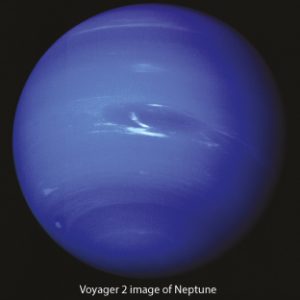Neptune
Neptune was discovered by the German astronomer Galle in 1846. The atmosphere on Neptune is like Uranus with hydrogen and helium but also ice, ammonia and methane. Methane and another unknown element give Neptune its bright blue colour. Neptune is more than 30 times further away from the Sun than the Earth. In 2011 Neptune completed its first 165-year orbit of the Sun since its discovery in 1846.
Most of what we know about Neptune is due to the flyby of the Voyager 2 spacecraft in 1989. Voyager 2 tracked an oval-shaped Great Dark Spot in Neptune’s southern hemisphere. This spot was a hurricane, large enough to contain the entire Earth, spinning anticlockwise and moving at almost 1,200km (750 miles) per hour.
Voyager 2 also discovered six of Neptune’s 13 known moons. Neptune’s largest moon, Triton, was discovered by William Lassell just 17 days after the discovery of Neptune. Triton orbits Neptune in the opposite direction to any other large planetary moon. This is probably because it was captured by Neptune’s gravitational force. It may once have been a dwarf planet in the Kuiper belt. Triton is the coldest object that has so far been measured in the Solar System, with surface temperatures of around –235°C (-391°F). Ice volcanoes on the surface of Triton shoot out liquid nitrogen, methane and dust, which freezes and falls back to the surface as snow. Voyager 2 took an image of an ice volcano shooting 8 km (5 miles) into the sky.
Neptune is named after the Roman god of the sea and its moons were named after other sea gods and nymphs from Greek mythology.

